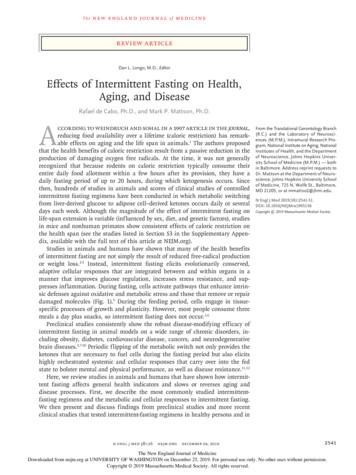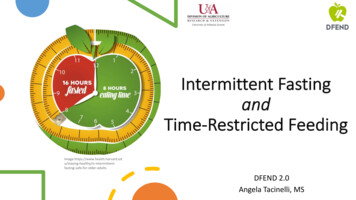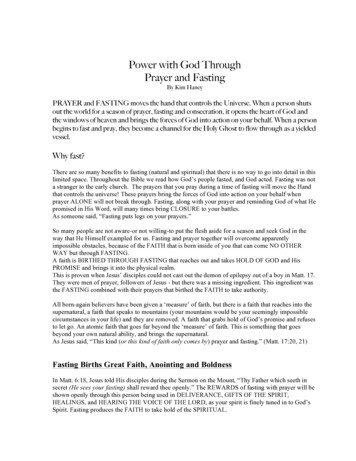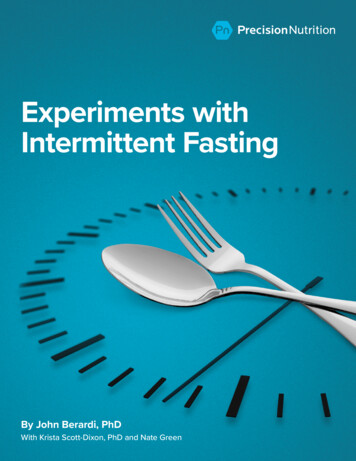
Transcription
Then e w e ng l a n d j o u r na lofm e dic i n eReview ArticleDan L. Longo, M.D., EditorEffects of Intermittent Fasting on Health,Aging, and DiseaseRafael de Cabo, Ph.D., and Mark P. Mattson, Ph.D.According to Weindruch and Sohal in a 1997 article in the Journal,reducing food availability over a lifetime (caloric restriction) has remarkable effects on aging and the life span in animals.1 The authors proposedthat the health benefits of caloric restriction result from a passive reduction in theproduction of damaging oxygen free radicals. At the time, it was not generallyrecognized that because rodents on caloric restriction typically consume theirentire daily food allotment within a few hours after its provision, they have adaily fasting period of up to 20 hours, during which ketogenesis occurs. Sincethen, hundreds of studies in animals and scores of clinical studies of controlledintermittent fasting regimens have been conducted in which metabolic switchingfrom liver-derived glucose to adipose cell–derived ketones occurs daily or severaldays each week. Although the magnitude of the effect of intermittent fasting onlife-span extension is variable (influenced by sex, diet, and genetic factors), studiesin mice and nonhuman primates show consistent effects of caloric restriction onthe health span (see the studies listed in Section S3 in the Supplementary Appendix, available with the full text of this article at NEJM.org).Studies in animals and humans have shown that many of the health benefitsof intermittent fasting are not simply the result of reduced free-radical productionor weight loss.2-5 Instead, intermittent fasting elicits evolutionarily conserved,adaptive cellular responses that are integrated between and within organs in amanner that improves glucose regulation, increases stress resistance, and suppresses inflammation. During fasting, cells activate pathways that enhance intrinsic defenses against oxidative and metabolic stress and those that remove or repairdamaged molecules (Fig. 1).5 During the feeding period, cells engage in tissuespecific processes of growth and plasticity. However, most people consume threemeals a day plus snacks, so intermittent fasting does not occur.2,6Preclinical studies consistently show the robust disease-modifying efficacy ofintermittent fasting in animal models on a wide range of chronic disorders, including obesity, diabetes, cardiovascular disease, cancers, and neurodegenerativebrain diseases.3,7-10 Periodic flipping of the metabolic switch not only provides theketones that are necessary to fuel cells during the fasting period but also elicitshighly orchestrated systemic and cellular responses that carry over into the fedstate to bolster mental and physical performance, as well as disease resistance.11,12Here, we review studies in animals and humans that have shown how intermittent fasting affects general health indicators and slows or reverses aging anddisease processes. First, we describe the most commonly studied intermittentfasting regimens and the metabolic and cellular responses to intermittent fasting.We then present and discuss findings from preclinical studies and more recentclinical studies that tested intermittent-fasting regimens in healthy persons and inn engl j med 381;26nejm.orgDecember 26, 2019From the Translational Gerontology Branch(R.C.) and the Laboratory of Neurosciences (M.P.M.), Intramural Research Program, National Institute on Aging, NationalInstitutes of Health, and the Departmentof Neuroscience, Johns Hopkins University School of Medicine (M.P.M.) — bothin Baltimore. Address reprint requests toDr. Mattson at the Department of Neuroscience, Johns Hopkins University Schoolof Medicine, 725 N. Wolfe St., Baltimore,MD 21205, or at mmattso2@jhmi.edu.N Engl J Med 2019;381:2541-51.DOI: 10.1056/NEJMra1905136Copyright 2019 Massachusetts Medical Society.2541The New England Journal of MedicineDownloaded from nejm.org at UNIVERSITY OF WASHINGTON on December 25, 2019. For personal use only. No other uses without permission.Copyright 2019 Massachusetts Medical Society. All rights reserved.
Then e w e ng l a n d j o u r na lProteinCHONeuroendocrine signalingFatRedox signalingNADHcAMP or PKANAD mTORSIRTsATP:AMPAcetyl teostasis Glucose or lipidand autophagymetabolismMitochondrialbiogenesism e dic i n eFigure 1. Cellular Responses to Energy Restriction ThatIntegrate Cycles of Feeding and Fasting with Metabolism.Total energy intake, diet composition, and length offasting between meals contribute to oscillations in theratios of the levels of the bioenergetic sensors nicotinamide adenine dinucleotide (NAD ) to NADH, ATP toAMP, and acetyl CoA to CoA. These intermediate energycarriers activate downstream proteins that regulate cellfunction and stress resistance, including transcriptionfactors such as forkhead box Os (FOXOs), peroxisomeproliferator–activated receptor γ coactivator 1α (PGC-1α),and nuclear factor erythroid 2–related factor 2 (NRF2);kinases such as AMP kinase (AMPK); and deacetylasessuch as sirtuins (SIRTs). Intermittent fasting triggersneuroendocrine responses and adaptations characterized by low levels of amino acids, glucose, and insulin.Down-regulation of the insulin–insulin-like growth factor 1 (IGF-1) signaling pathway and reduction of circulating amino acids repress the activity of mammaliantarget of rapamycin (mTOR), resulting in inhibition ofprotein synthesis and stimulation of autophagy. Duringfasting, the ratio of AMP to ATP is increased and AMPKis activated, triggering repair and inhibition of anabolicprocesses. Acetyl coenzyme A (CoA) and NAD serveas cofactors for epigenetic modifiers such as SIRTs.SIRTs deacetylate FOXOs and PGC-1α, resulting in theexpression of genes involved in stress resistance andmitochondrial biogenesis. Collectively, the organismresponds to intermittent fasting by minimizing anabolicprocesses (synthesis, growth, and reproduction), favoring maintenance and repair systems, enhancing stressresistance, recycling damaged molecules, stimulatingmitochondrial biogenesis, and promoting cell survival,all of which support improvements in health and diseaseresistance. The abbreviation cAMP denotes cyclic AMP,CHO carbohydrate, PKA protein kinase A, and redoxreduction–oxidation.Intermittent fasting and caloric restrictionNutrientsofCellsurvivalHealth and stress resistancepatients with metabolic disorders (obesity, insulin resistance, hypertension, or a combination ofthese disorders). Finally, we provide practicalinformation on how intermittent-fasting regimens can be prescribed and implemented. Thepractice of long-term fasting (from many days toweeks) is not discussed here, and we refer interested readers to the European clinical experience with such fasting protocols.13In ter mi t ten t Fa s t inga nd Me ta bol ic S w i t chingGlucose and fatty acids are the main sources ofenergy for cells. After meals, glucose is used forenergy, and fat is stored in adipose tissue as2542n engl j med 381;26triglycerides. During periods of fasting, triglycerides are broken down to fatty acids and glycerol,which are used for energy. The liver convertsfatty acids to ketone bodies, which provide amajor source of energy for many tissues, especially the brain, during fasting (Fig. 2). In thefed state, blood levels of ketone bodies are low,and in humans, they rise within 8 to 12 hoursafter the onset of fasting, reaching levels as highas 2 to 5 mM by 24 hours.14,15 In rodents, an elevation of plasma ketone levels occurs within 4 to8 hours after the onset of fasting, reaching millimolar levels within 24 hours.16 The timing ofthis response gives some indication of the appropriate periods for fasting in intermittentfasting regimens.2,3In humans, the three most widely studiedintermittent-fasting regimens are alternate-daynejm.orgDecember 26, 2019The New England Journal of MedicineDownloaded from nejm.org at UNIVERSITY OF WASHINGTON on December 25, 2019. For personal use only. No other uses without permission.Copyright 2019 Massachusetts Medical Society. All rights reserved.
Effects of Intermit tent Fasting on Health and cetateβ-HBFFAAcyl CoAATP production Mitochondrial biogenesis Autophagy mTOR pathwayβ-HBVasculatureLiver(hepatocyte)Improved performanceStress resistanceFFABrain(neuron)BDNF signalingSynaptic adipocyte)Figure 2. Metabolic Adaptations to Intermittent Fasting.Energy restriction for 10 to 14 hours or more results in depletion of liver glycogen stores and hydrolysis of triglycerides (TGs) to free fattyacids (FFAs) in adipocytes. FFAs released into the circulation are transported into hepatocytes, where they produce the ketone bodiesacetoacetate and β-hydroxybutyrate (β-HB). FFAs also activate the transcription factors peroxisome proliferator–activated receptor α(PPAR-α) and activating transcription factor 4 (ATF4), resulting in the production and release of fibroblast growth factor 21 (FGF21), aprotein with widespread effects on cells throughout the body and brain. β-HB and acetoacetate are actively transported into cells wherethey can be metabolized to acetyl CoA, which enters the tricarboxylic acid (TCA) cycle and generates ATP. β-HB also has signaling functions, including the activation of transcription factors such as cyclic AMP response element–binding protein (CREB) and nuclear factor κB(NF-κB) and the expression of brain-derived neurotrophic factor (BDNF) in neurons. Reduced levels of glucose and amino acids duringfasting result in reduced activity of the mTOR pathway and up-regulation of autophagy. In addition, energy restriction stimulates mitochondrial biogenesis and mitochondrial uncoupling.fasting, 5:2 intermittent fasting (fasting 2 dayseach week), and daily time-restricted feeding.11Diets that markedly reduce caloric intake on 1 dayor more each week (e.g., a reduction to 500 to700 calories per day) result in elevated levels ofketone bodies on those days.17-20 The metabolicswitch from the use of glucose as a fuel sourceto the use of fatty acids and ketone bodies results in a reduced respiratory-exchange ratio (theratio of carbon dioxide produced to oxygen consumed), indicating the greater metabolic flexibility and efficiency of energy production fromfatty acids and ketone bodies.3n engl j med 381;26Ketone bodies are not just fuel used duringperiods of fasting; they are potent signalingmolecules with major effects on cell and organfunctions.21 Ketone bodies regulate the expression and activity of many proteins and moleculesthat are known to influence health and aging.These include peroxisome proliferator–activatedreceptor γ coactivator 1α (PGC-1α), fibroblastgrowth factor 21,22,23 nicotinamide adenine dinucleotide (NAD ), sirtuins,24 poly(adenosine diphosphate [ADP]–ribose) polymerase 1 (PARP1), andADP ribosyl cyclase (CD38).25 By influencing thesemajor cellular pathways, ketone bodies producednejm.orgDecember 26, 20192543The New England Journal of MedicineDownloaded from nejm.org at UNIVERSITY OF WASHINGTON on December 25, 2019. For personal use only. No other uses without permission.Copyright 2019 Massachusetts Medical Society. All rights reserved.
Then e w e ng l a n d j o u r na lduring fasting have profound effects on systemicmetabolism. Moreover, ketone bodies stimulateexpression of the gene for brain-derived neurotrophic factor (Fig. 2), with implications forbrain health and psychiatric and neurodegenerative disorders.5How much of the benefit of intermittent fasting is due to metabolic switching and how muchis due to weight loss? Many studies have indicated that several of the benefits of intermittentfasting are dissociated from its effects on weightloss. These benefits include improvements inglucose regulation, blood pressure, and heart rate;the efficacy of endurance training26,27; and abdominal fat loss27 (see Supplementary Section S1).In ter mi t ten t Fa s t inga nd S t r e ss R e sis ta nceIn contrast to people today, our human ancestors did not consume three regularly spaced,large meals, plus snacks, every day, nor did theylive a sedentary life. Instead, they were occupiedwith acquiring food in ecologic niches in whichfood sources were sparsely distributed. Over time,Homo sapiens underwent evolutionary changes thatsupported adaptation to such environments, including brain changes that allowed creativity,imagination, and language and physical changesthat enabled species members to cover large distances on their own muscle power to stalk prey.6The research reviewed here, and discussed inmore detail elsewhere,11,12 shows that most if notall organ systems respond to intermittent fasting in ways that enable the organism to tolerate or overcome the challenge and then restorehomeostasis. Repeated exposure to fasting periods results in lasting adaptive responses thatconfer resistance to subsequent challenges. Cellsrespond to intermittent fasting by engaging in acoordinated adaptive stress response that leadsto increased expression of antioxidant defenses,DNA repair, protein quality control, mitochondrial biogenesis and autophagy, and down-regulation of inflammation (Fig. 3). These adaptiveresponses to fasting and feeding are conservedacross taxa.10 Cells throughout the bodies andbrains of animals maintained on intermittentfasting regimens show improved function androbust resistance to a broad range of potentiallydamaging insults, including those involving meta-2544n engl j med 381;26ofm e dic i n ebolic, oxidative, ionic, traumatic, and proteotoxicstress.12 Intermittent fasting stimulates autophagyand mitophagy while inhibiting the mTOR (mammalian target of rapamycin) protein-synthesispathway. These responses enable cells to removeoxidatively damaged proteins and mitochondriaand recycle undamaged molecular constituentswhile temporarily reducing global protein synthesis to conserve energy and molecular resources(Fig. 3). These pathways are untapped or suppressed in persons who overeat and are sedentary.12Effec t s of In ter mi t ten t Fa s t ingon He a lth a nd AgingUntil recently, studies of caloric restriction andintermittent fasting focused on aging and thelife span. After nearly a century of research oncaloric restriction in animals, the overall conclusion was that reduced food intake robustly increases the life span.In one of the earliest studies of intermittentfasting, Goodrick and colleagues reported thatthe average life span of rats is increased by up to80% when they are maintained on a regimen ofalternate-day feeding, started when they areyoung adults. However, the magnitude of theeffects of caloric restriction on the health spanand life span varies and can be influenced bysex, diet, age, and genetic factors.7 A meta-analysis of data available from 1934 to 2012 showedthat caloric restriction increases the median lifespan by 14 to 45% in rats but by only 4 to 27%in mice.28 A study of 41 recombinant inbredstrains of mice showed wide variation, rangingfrom a substantially extended life span to ashortened life span, depending on the strain andsex.29,30 However, the study used only one caloricrestriction regimen (40% restriction) and did notevaluate health indicators, causes of death, orunderlying mechanisms. There was an inverserelationship between adiposity and life span29suggesting that animals with a shortened lifespan had a greater reduction in adiposity andtransitioned more rapidly to starvation whensubjected to such severe caloric restriction,whereas animals with an extended life span hadthe least reduction in fat.The discrepant results of two landmark studies in monkeys challenged the link betweenhealth-span extension and life-span extensionnejm.orgDecember 26, 2019The New England Journal of MedicineDownloaded from nejm.org at UNIVERSITY OF WASHINGTON on December 25, 2019. For personal use only. No other uses without permission.Copyright 2019 Massachusetts Medical Society. All rights reserved.
Effects of Intermit tent Fasting on Health and AgingPeriods of IntermittentFastingExerciseSystemic and cellularadaptations to bioenergeticchallenge (ketogenesis)Periods of Recovery(eating, temic and cellular adaptations to energy repletion(ketone-to-glucose switch)Increased ketones(β-HB, acetoacetate)Increased mitochondrialstress resistanceIncreased antioxidantdefensesIncreased autophagyIncreased DNA repairDecreased insulinDecreased mTORDecreased protein synthesisIncreased glucoseIncreased insulinIncreased mTORIncreased protein synthesisIncreased mitochondrialbiogenesisDecreased ketones(β-HB, acetoacetate)Decreased autophagyIncreased insulin sensitivityIncreased HRVImproved lipid metabolismHealthy gut microbiotaReduced abdominal fatReduced inflammationReduced blood pressureResistance of cellsand organs to stress(metabolic, oxidative,ischemic, proteotoxic)Cell growth and plasticityStructural and functionaltissue remodelingResilienceDisease resistanceFigure 3. Cellular and Molecular Mechanisms Underlying Improved Organ Function and Resistance to Stressand Disease with Intermittent Metabolic Switching.Periods of dietary energy restriction sufficient to cause depletion of liver glycogen stores trigger a metabolic switchtoward use of fatty acids and ketones. Cells and organ systems adapt to this bioenergetic challenge by activatingsignaling pathways that bolster mitochondrial function, stress resistance, and antioxidant defenses while up-regulatingautophagy to remove damaged molecules and recycle their components. During the period of energy restriction, cellsadopt a stress-resistance mode through reduction in insulin signaling and overall protein synthesis. Exercise enhancesthese effects of fasting. On recovery from fasting (eating and sleeping), glucose levels increase, ketone levels plummet, and cells increase protein synthesis, undergoing growth and repair. Maintenance of an intermittent-fasting regimen, particularly when combined with regular exercise, results in many long-term adaptations that improve mentaland physical performance and increase disease resistance. HRV denotes heart-rate variability.with caloric restriction. One of the studies, at theUniversity of Wisconsin, showed a positive effectof caloric restriction on both health and survival,31 whereas the other study, at the NationalInstitute on Aging, showed no significant reduction in mortality, despite clear improvements inoverall health.32 Differences in the daily caloricintake, onset of the intervention, diet composition,feeding protocols, sex, and genetic backgroundmay explain the differential effects of caloricrestriction on life span in the two studies.7In humans, intermittent-fasting interventionsameliorate obesity, insulin resistance, dyslipidemia, hypertension, and inflammation.33 Intermittent fasting seems to confer health benefits to an engl j med 381;26greater extent than can be attributed just to a reduction in caloric intake. In one trial, 16 healthyparticipants assigned to a regimen of alternateday fasting for 22 days lost 2.5% of their initialweight and 4% of fat mass, with a 57% decreasein fasting insulin levels.34 In two other trials,overweight women (approximately 100 womenin each trial) were assigned to either a 5:2 intermittent-fasting regimen or a 25% reduction indaily caloric intake. The women in the twogroups lost the same amount of weight duringthe 6-month period, but those in the group assigned to 5:2 intermittent fasting had a greaterincrease in insulin sensitivity and a larger reduction in waist circumference.20,27nejm.orgDecember 26, 20192545The New England Journal of MedicineDownloaded from nejm.org at UNIVERSITY OF WASHINGTON on December 25, 2019. For personal use only. No other uses without permission.Copyright 2019 Massachusetts Medical Society. All rights reserved.
Then e w e ng l a n d j o u r na lPh ysic a l a nd C o gni t i v e Effec t sof In ter mi t ten t Fa s t ingIn animals and humans, physical function isimproved with intermittent fasting. For example,despite having similar body weight, mice maintained on alternate-day fasting have better running endurance than mice that have unlimitedaccess to food. Balance and coordination are alsoimproved in animals on daily time-restricted feeding or alternate-day fasting regimens.35 Youngmen who fast daily for 16 hours lose fat whilemaintaining muscle mass during 2 months ofresistance training.36Studies in animals show that intermittentfasting enhances cognition in multiple domains,including spatial memory, associative memory,and working memory37; alternate-day fasting anddaily caloric restriction reverse the adverse effectsof obesity, diabetes, and neuroinflammation onspatial learning and memory (see Section S4).In a clinical trial, older adults on a short-termregimen of caloric restriction had improved verbal memory.38 In a study involving overweightadults with mild cognitive impairment, 12 monthsof caloric restriction led to improvements in verbal memory, executive function, and global cognition.39 More recently, a large, multicenter, randomized clinical trial showed that 2 years of dailycaloric restriction led to a significant improvement in working memory.40 There is certainly aneed to undertake further studies of intermittentfasting and cognition in older people, particularly given the absence of any pharmacologictherapies that influence brain aging and progression of neurodegenerative diseases.12Cl inic a l A ppl ic at ionsIn this section, we briefly review examples offindings from studies of intermittent fasting inpreclinical animal models of disease and in patients with various diseases. Additional publishedstudies are listed in Section S5.Obesity and Diabetes MellitusIn animal models, intermittent feeding improvesinsulin sensitivity, prevents obesity caused by ahigh-fat diet, and ameliorates diabetic retinopathy.41 On the island of Okinawa, the traditionalpopulation typically maintains a regimen of in-2546n engl j med 381;26ofm e dic i n etermittent fasting and has low rates of obesityand diabetes mellitus, as well as extreme longevity.42 Okinawans typically consume a low-caloriediet from energy-poor but nutrient-rich sources,particularly Okinawan sweet potatoes, other vegetables, and legumes.42 Likewise, members of theCalorie Restriction Society, who follow the CRON(Calorie Restriction with Optimal Nutrition)diet,43-45 have low rates of diabetes mellitus, withlow levels of insulin-like growth factor 1, growthhormone, and markers of inflammation andoxidative stress.4,20,33,43A multicenter study showed that daily caloricrestriction improves many cardiometabolic riskfactors in nonobese humans.46-50 Furthermore, sixshort-term studies involving overweight or obeseadults have shown that intermittent fasting is aseffective for weight loss as standard diets.51 Tworecent studies showed that daily caloric restriction or 4:3 intermittent fasting (24-hour fastingthree times a week) reversed insulin resistance inpatients with prediabetes or type 2 diabetes.52,53However, in a 12-month study comparing alternate-day fasting, daily caloric restriction, and acontrol diet, participants in both interventiongroups lost weight but did not have any improvements in insulin sensitivity, lipid levels, or bloodpressure, as compared with participants in thecontrol group.54Cardiovascular DiseaseIntermittent fasting improves multiple indicatorsof cardiovascular health in animals and humans,including blood pressure; resting heart rate; levels of high-density and low-density lipoprotein(HDL and LDL) cholesterol, triglycerides, glucose, and insulin; and insulin resistance.41,43,47,55In addition, intermittent fasting reduces markersof systemic inflammation and oxidative stressthat are associated with atherosclerosis.17,27,36,56Analyses of electrocardiographic recordings showthat intermittent fasting increases heart-rate variability by enhancing parasympathetic tone inrats57 and humans.58 The CALERIE (Comprehensive Assessment of Long-Term Effects of Reducing Intake of Energy) study showed that a 12%reduction in daily calorie intake for a period of2 years improves many cardiovascular risk factorsin nonobese persons.46-50 Varady et al. reportedthat alternate-day fasting was effective for weightloss and cardioprotection in normal-weight andnejm.orgDecember 26, 2019The New England Journal of MedicineDownloaded from nejm.org at UNIVERSITY OF WASHINGTON on December 25, 2019. For personal use only. No other uses without permission.Copyright 2019 Massachusetts Medical Society. All rights reserved.
Effects of Intermit tent Fasting on Health and Agingoverweight adults.59 Improvements in cardiovascular health indicators typically become evidentwithin 2 to 4 weeks after the start of alternateday fasting and then dissipate over a period ofseveral weeks after resumption of a normal diet.57position of intermittent fasting during chemotherapy. No studies have yet determined whetherintermittent fasting affects cancer recurrence inhumans.9Neurodegenerative DisordersCancerMore than a century ago, Moreschi and Rousdescribed the beneficial effect of fasting andcaloric restriction on tumors in animals. Sincethen, numerous studies in animals have shownthat daily caloric restriction or alternate-dayfasting reduces the occurrence of spontaneoustumors during normal aging in rodents and suppresses the growth of many types of inducedtumors while increasing their sensitivity to chemotherapy and irradiation.7-9,60 Similarly, intermittent fasting is thought to impair energy metabolism in cancer cells, inhibiting their growthand rendering them susceptible to clinical treatments.61-63 The underlying mechanisms involve areduction of signaling through the insulin andgrowth hormone receptors and an enhancementof the forkhead box O (FOXO) and nuclear factorerythroid 2–related factor 2 (NRF2) transcriptionfactors. Genetic deletion of NRF2 or FOXO1obliterates the protective effects of intermittentfasting against induced carcinogenesis while preserving extension of the life span,64,65 and deletion of FOXO3 preserves the anticancer protectionbut diminishes the longevity effect.66 Activationof these transcription factors and downstreamtargets by means of intermittent fasting mayprovide protection against cancer while bolstering the stress resistance of normal cells (Fig. 1).Clinical trials of intermittent fasting in patients with cancer have been completed or are inprogress. Most of the initial trials have focusedon compliance, side effects, and characterizationof biomarkers. For example, a trial of daily caloric restriction in men with prostate cancershowed excellent adherence (95%) and no adverse events.67 Several case studies involving patients with glioblastoma suggest that intermittentfasting can suppress tumor growth and extendsurvival.9,68 Ongoing trials listed on ClinicalTrials.gov focus on intermittent fasting in patientswith breast, ovarian, prostate, endometrial, andcolorectal cancers and glioblastoma (see Supplementary Table S1). Specific intermittent-fastingregimens vary among studies, but all involve im-n engl j med 381;26Epidemiologic data suggest that excessive energyintake, particularly in midlife, increases the risksof stroke, Alzheimer’s disease, and Parkinson’sdisease.69 There is strong preclinical evidence thatalternate-day fasting can delay the onset andprogression of the disease processes in animalmodels of Alzheimer’s disease and Parkinson’sdisease.5,12 Intermittent fasting increases neuronalstress resistance through multiple mechanisms,including bolstering mitochondrial function andstimulating autophagy, neurotrophic-factor production, antioxidant defenses, and DNA repair.12,70Moreover, intermittent fasting enhances GABAergic inhibitory neurotransmission (i.e., γ-aminobutyric acid–related inhibitory neurotransmission),which can prevent seizures and excitotoxicity.71Data from controlled trials of intermittent fasting in persons at risk for or affected by a neurodegenerative disorder are lacking. Ideally, anintervention would be initiated early in the disease process and continued long enough to detect a disease-modifying effect of the intervention (e.g., a 1-year study).Asthma, Multiple Sclerosis, and ArthritisWeight loss reduces the symptoms of asthma inobese patients.72 In one study, patients who adhered to the alternate-day fasting regimen had anelevated serum level of ketone bodies on energyrestriction days and lost weight over a 2-monthperiod, during which asthma symptoms andairway resistance were mitigated.17 A reductionin symptoms was associated with significantreductions in serum levels of markers of inflammation and oxidative stress.17 Multiple sclerosisis an autoimmune disorder characterized by axondemyelination and neuronal degeneration in thecentral nervous system. Alternate-day fasting andperiodic cycles of 3 consecutive days of energyrestriction reduce autoimmune demyelinationand improve the functional outcome in a mousemodel of multiple sclerosis (experimentally induced autoimmune encephalomyelitis).73,74 Tworecent pilot studies showed that patients withmultiple sclerosis who adhere to intermittent-nejm.orgDecember 26, 20192547The New England Journal of MedicineDownloaded from nejm.org at UNIVERSITY OF WASHINGTON on December 25, 2019. For personal use only. No other uses without permission.Copyright 2019 Massachusetts Medical Society. All rights reserved.
Then e w e ng l a n d j o u r na lfasting regimens have reduced symptoms in asshort a period as 2 months.73,75 Because it reduces inflammation,17 intermittent fasting wouldalso be expected to be beneficial in rheumatoidarthritis, and indeed, there is evidence supporting its use in patients with arthritis.76Surgical and Ischemic Tissue InjuryIntermittent-fasting regimens reduce tissu
the efficacy of endurance training26,27; and ab-dominal fat loss 27 (see Supplementary Section S1). Intermittent Fasting and Stress Resistance In contrast to people today, our human ances-tors did not consume three regularly spaced, large meals, plus snacks, every day, nor di










